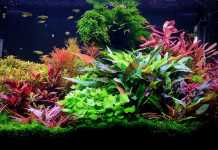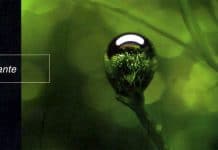Nitrogen, phosphates, CO2
Q. Which is your opinion on plain NO3– fertilizers? Do they work better than mixed nitrogen ones (i.e. with nitrate nitrogen, ammoniacal nitrogen and urea nitrogen) in heavy planted tank?
A. I use mostly KNO3, I’ve not found adding NH4 helps and can lead to more issues for many aquarist. NH4 works well in the soil as it binds to clays, but not so well in the water column.
Q. I have never read your thought about NO3– [nitrates]: why?
A. Many hobbyists claimed the need to keep it low, at about 5 ppm, for the welfare of the fish; others instead, over dosed it. Those latter noted that some plant species did better at 10-20 ppm.
Q. Do you think 10-20 ppm is an optimal level? In other words, can we say that this level is even a limiting factor for some species like Egeria?
Conversely, which plants, in your opinion, do better with low nitrates?
Someones claim that some plants cannot turn red if NO3– are higher than 10 ppm. I’ve personally observed this on a simple Phyllanthus, but perhaps it was just a coincidence…

A. Not sure, some plants seem better with low nutrients in the water but rich sediments, but only a very few (20-30 species), the rest do not care.
But 10 ppm or over is good. I have very red plants at higher NO3–. Some hobbyists claimed some species stunted at higher levels.
Liebig’s law still applies: if you limit one thing, it’ll reduce say CO2 demand. When you remove that limitation, then CO2 becomes limiting and you see stunted tips. Same for K+ at higher levels and other fertilizers.
There are many other factors to good growth that enhance red color that have nothing to do with NO3– ppm.
Q. I think I read on a forum that you normally keep PO43- at 4 ppm or higher, right?
A. I keep about 3-5 ppm PO43-.
Q. You have probably been the first one to tell the world that plants grow better with PO43-.
A. I didn’t discover phosphate, nor the fact that they promote plants growth.
Steve Dixon actually proposed this hypothesis. I just provided the aquarium and example.

Steve’s tap water had no PO43- to speak of in it, mine was rich. So we got lucky.
[My] tank was 0 to 0.2 ppm, tap water was about 1.1 ppm. Clearly the PO43- was goign somewhere and high PO43- (over 0.2ppm) = algae was false.
Later, he went back and dosed KH2PO4 and his tank responded like mine.
At that point we all agreed that the hypothesis was incorrect that suggested PO43- above 0.2 ppm causes algae issues in planted tanks. Algae must be caused by other factors.
I suppose the PO43- was a larger myth and was central to many aquarist hypothesis about algae blooms. Most of the older research suggested it.
But new research suggest there is no relationship in natural lakes and ponds where plants are present and the lakes do not freeze over.
Q. Well, in a forum some guys showed you a scientific research stating the opposite and your straight answer was: aquarium is not a lake. I agree with you. Indeed, which lake has 30 ppm CO2, or balanced fertilizers? So, the comparison is useless.
A. Research can show the opposite, but the research may have poor assumptions. You need to carefully look at the research before assuming it applies and it supports what you say.

The University of Florida does the most research on aquatic plants due to weed control and the 4700 lakes that have over 4 hectares. Subtropical and does not freeze over, like our own aquariums.
CO2 can vary from 5 ppm to 30-40 ppm. Depends, springs are richer, but larger lakes can have a lot of CO2 relative to the plant biomass.
Ferts can be in the water or the sediment.
Q. CO2 estimation in CO2 enriched tanks is a bit tricky under certain circumstances, for example tables don’t work well if you use peat moss, hardwood leaves, drift wood, etc.
Which method do you use, and which one work best in most cases in your opinion?
And finally, which is the typical CO2 range in non CO2 tanks, if you have ever measured it?
A. You can do large water changes if you have tannins, peat etc. Then take the reading. Set the CO2, then ignore the pH etc once the peat or tannins are added back to the water. As long as the flow of CO2 is stable, the ppm’s should be also, regardless of pH or KH.
Note
In tanks without fishes, this is probably the best way to evaluate the CO2 concentration, because there will be no acid that would falsify the measurement. As esplained in Paky’s CO2 e carbonati (in Italian), the same quantity of CO2 is needed to decrease the pH by 1, whatever the value of KH of the water. Anyway, if the tank is populated, our beloved fishes win not be very happy to undergo a rapid and important water change.

You can use the relative CO2 pH method also. 1 pH unit drop = about 30 ppm, 1.2 pH drop = 45 ppm and so on.
Note
Also in this case, it is necessary to have some caution. If we have any material containing carbonates, without knowing it, we risk to intoxicate the fishes with too much CO2. In fact, by lowering the pH, the carbonaceus materials would start to release alkalizing agents to contrast the decrease of the pH. If we insist in pumping more CO2 to decrease the pH, we risk the intoxication of the fishes.
Or do large water changes with RO/DI and add baking soda to give say a 1 KH.
There are also other methods.
Non CO2 tanks vary widely and depending on time of day, can go from 8-10 ppm to zero.





















